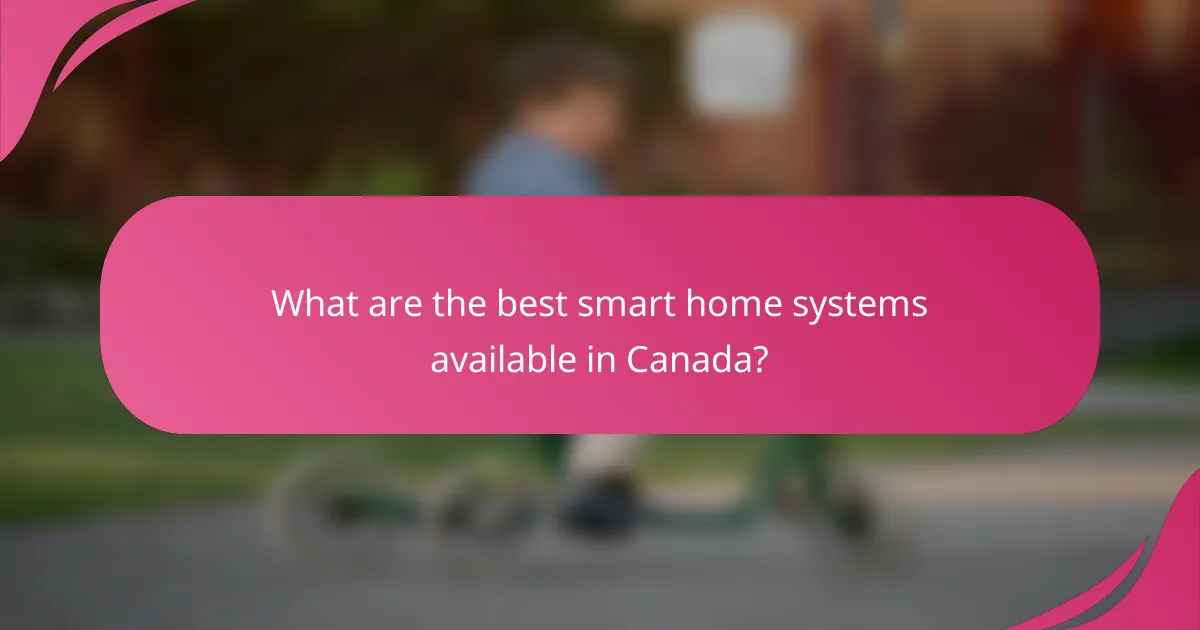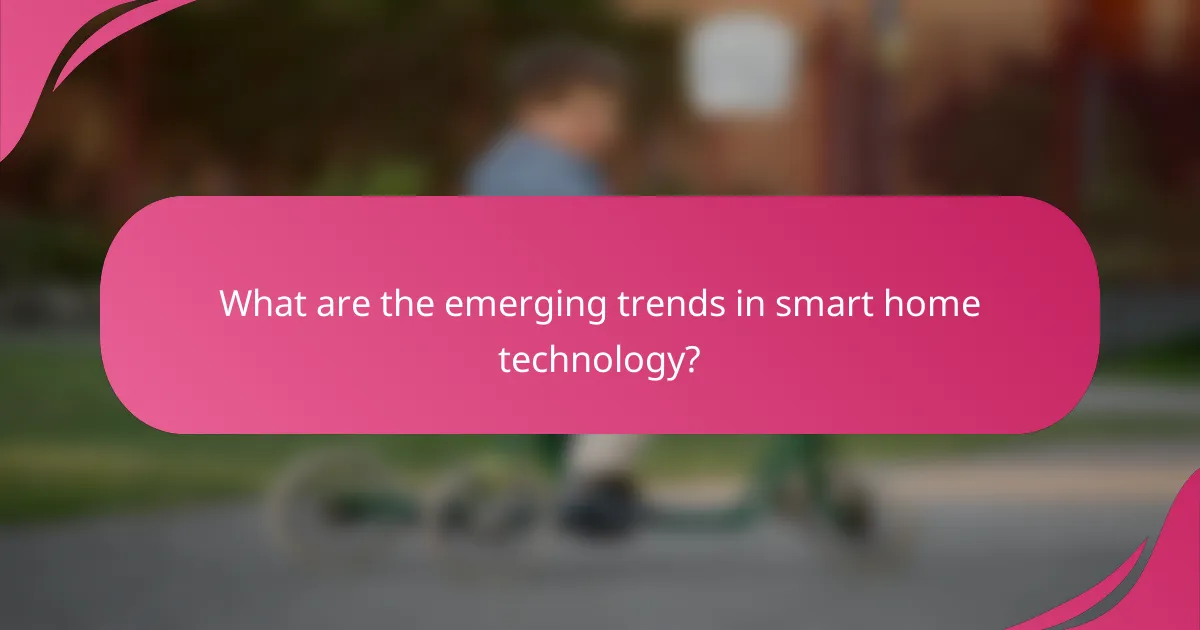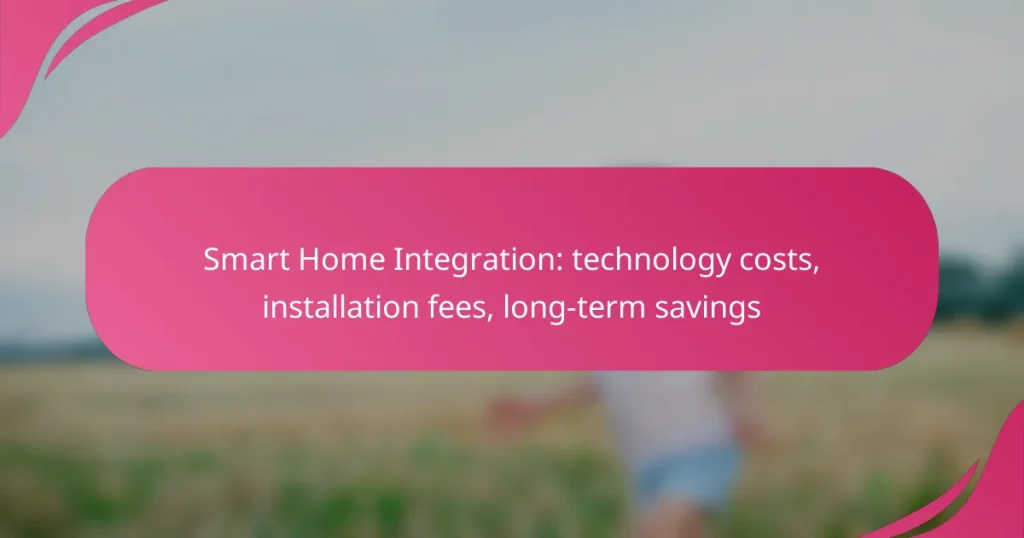Smart home integration offers homeowners a blend of convenience and efficiency, but the costs can vary widely depending on the technology and installation complexity. While initial expenses may seem daunting, the potential for long-term savings on energy bills and increased property value makes it a worthwhile investment. By embracing smart technologies, homeowners can optimize resource usage and reduce ongoing expenses over time.

What are the costs of smart home integration in Canada?
The costs of smart home integration in Canada can vary significantly based on the technology chosen and the complexity of the installation. Homeowners should anticipate initial expenses for devices and installation, as well as potential long-term savings on energy bills and increased home value.
Average technology costs
The average costs for smart home devices in Canada typically range from a few hundred to several thousand Canadian dollars, depending on the type and number of devices. Basic systems, such as smart thermostats or lighting, can start around CAD 100 to CAD 300, while comprehensive setups including security systems and home automation can exceed CAD 2,000.
When budgeting for smart home technology, consider both the upfront costs and any ongoing subscription fees for services or cloud storage. Many devices offer free basic features, but advanced functionalities may require additional payments.
Installation fees overview
Installation fees for smart home systems in Canada can vary based on the complexity of the setup and whether professional help is needed. Basic installations may cost around CAD 100 to CAD 300, while more intricate systems could require CAD 500 or more, especially if electrical work or extensive wiring is involved.
Homeowners can save on installation costs by opting for DIY solutions, but it’s crucial to ensure compatibility between devices and to follow safety guidelines. Hiring a professional can provide peace of mind and ensure a seamless integration.
Comparative pricing of popular systems
Popular smart home systems in Canada include Google Nest, Amazon Echo, and Apple HomeKit, each with varying price points and features. For instance, a basic Google Nest setup may cost around CAD 200, while a comprehensive Amazon Echo system can range from CAD 300 to CAD 1,000, depending on the devices included.
When comparing systems, consider not only the initial costs but also the ecosystem compatibility, ease of use, and available features. It’s advisable to read reviews and possibly test devices in-store to determine which system best fits your needs and budget.

How can smart home integration save money long-term?
Smart home integration can lead to significant long-term savings through various means, including energy efficiency, reduced insurance costs, and lower maintenance expenses. By investing in smart technologies, homeowners can optimize their resource usage and minimize unnecessary expenditures over time.
Energy savings from smart thermostats
Smart thermostats can adjust heating and cooling based on your schedule and preferences, leading to energy savings of around 10-15% on utility bills. These devices learn your habits and can make real-time adjustments to optimize energy use, which is especially beneficial during peak hours.
For example, if you typically leave home during the day, a smart thermostat can lower the temperature while you are away and warm it back up before you return. This not only enhances comfort but also reduces energy waste.
Reduced insurance premiums
Integrating smart home technology can lead to lower homeowners insurance premiums. Many insurance companies offer discounts for homes equipped with smart security systems, smoke detectors, and water leak sensors, as these features reduce the risk of damage and theft.
Homeowners can save anywhere from 5-20% on their premiums, depending on the level of smart technology installed. It’s advisable to check with your insurance provider to understand the specific discounts available for smart home features.
Maintenance cost reductions
Smart home devices can help in proactive maintenance, which can save money on repairs. For instance, smart leak detectors can alert you to water leaks before they cause significant damage, potentially saving thousands in repairs.
Additionally, smart appliances often come with diagnostic features that can notify you of issues before they escalate. Regular maintenance reminders can also help ensure that systems like HVAC are running efficiently, reducing long-term operational costs.

What are the best smart home systems available in Canada?
The best smart home systems in Canada include Google Nest Hub, Amazon Echo Show, and Samsung SmartThings. Each offers unique features and capabilities that cater to different user needs and preferences.
Google Nest Hub features
The Google Nest Hub serves as a central control point for various smart devices, integrating seamlessly with Google Assistant. It allows users to manage their smart home through voice commands or a user-friendly touchscreen interface.
Key features include a built-in speaker for music and video playback, compatibility with numerous smart home devices, and the ability to display information like weather updates and calendar events. The Nest Hub also supports routines, enabling users to automate multiple actions with a single command.
Amazon Echo Show capabilities
The Amazon Echo Show combines Alexa’s voice control with a vibrant display, making it ideal for video calls and streaming content. Users can interact with their smart home devices, check security cameras, and view recipes directly on the screen.
Its capabilities extend to controlling compatible devices, setting reminders, and accessing a wide range of skills through Alexa. The Echo Show’s video capabilities, including video calling and streaming services, enhance its functionality beyond basic smart home control.
Samsung SmartThings integration
Samsung SmartThings acts as a comprehensive hub for connecting various smart devices, regardless of brand. It allows users to create customized automations and monitor their home environment through a single app.
SmartThings supports a wide array of devices, including lights, locks, and sensors, making it versatile for different setups. Users can set up routines to automate tasks, such as turning off lights when leaving home or adjusting the thermostat based on occupancy.

What factors should be considered before installation?
Before installing smart home technology, consider compatibility with existing systems, budget for devices and installation, and potential long-term savings. Evaluating these factors ensures a smoother integration process and maximizes the benefits of smart technology.
Home compatibility requirements
Assessing home compatibility is crucial for successful smart home integration. Check if your current wiring, internet connectivity, and existing devices support the new technology. For instance, some smart devices require a stable Wi-Fi network, while others may need specific protocols like Zigbee or Z-Wave.
Additionally, consider the age of your home. Older homes may need upgrades to accommodate smart devices, which could increase installation costs. A professional assessment can help identify necessary modifications.
Budget planning for smart devices
Budgeting for smart home devices involves more than just the purchase price. Factor in installation fees, which can vary widely depending on the complexity of the setup and the number of devices. Basic installations might cost a few hundred USD, while more extensive systems can run into the thousands.
Also, consider ongoing costs such as subscription services for smart home features or cloud storage. To manage expenses, prioritize devices that offer the most value and functionality for your lifestyle, and look for bundled packages that can reduce overall costs.

How does smart home technology impact property value?
Smart home technology can significantly enhance property value by making homes more appealing to buyers. Features like automated lighting, security systems, and energy-efficient devices not only improve convenience but also contribute to long-term savings, making properties with these technologies more desirable.
Market trends in smart home features
The demand for smart home features has been steadily increasing, driven by consumer interest in convenience and energy efficiency. Popular technologies include smart thermostats, security cameras, and voice-activated assistants, which are becoming standard in new constructions and renovations.
Homebuyers are increasingly looking for properties equipped with smart technology, often willing to pay a premium for homes that offer these features. As a result, properties with advanced smart home systems can stand out in competitive markets.
Appraisal increases from smart technology
Integrating smart technology can lead to higher appraisals, as these features are viewed as valuable upgrades. Appraisers often consider the presence of smart systems when determining a home’s market value, which can lead to increases of several percentage points in property assessments.
However, the exact increase in value can vary based on the type and quality of the technology installed. For instance, a comprehensive smart security system may yield a higher return than basic smart lighting. Homeowners should focus on high-demand features to maximize appraisal benefits.

What are the emerging trends in smart home technology?
Emerging trends in smart home technology focus on enhanced automation, energy efficiency, and security. These advancements aim to improve user convenience, reduce energy costs, and provide better protection for homes.
Integration of AI in home automation
The integration of artificial intelligence (AI) in home automation allows devices to learn user preferences and behaviors. This enables systems to optimize settings automatically, such as adjusting lighting and temperature based on daily routines.
For instance, smart thermostats can analyze past usage patterns to suggest energy-saving schedules. Homeowners can expect to see more AI-driven devices that communicate with each other, creating a seamless user experience.
Growth of energy-efficient devices
Energy-efficient devices are becoming increasingly popular as homeowners seek to reduce utility bills and environmental impact. These devices often include smart lighting, energy-efficient appliances, and smart plugs that monitor and control energy consumption.
Investing in energy-efficient technology can lead to savings of around 10-30% on energy costs over time. Additionally, many regions offer incentives or rebates for installing such devices, making them more financially attractive.
Future of smart home security systems
The future of smart home security systems is focused on advanced features like facial recognition, remote monitoring, and integration with other smart devices. These systems provide homeowners with real-time alerts and the ability to control security measures from anywhere.
As technology evolves, expect to see more affordable options with sophisticated capabilities, such as smart locks and doorbell cameras. Homeowners should consider systems that offer robust encryption and comply with local regulations to ensure data security and privacy.


